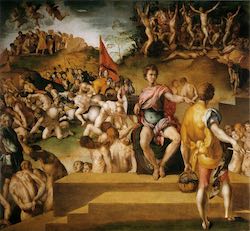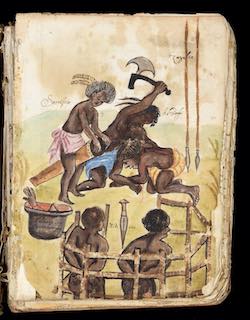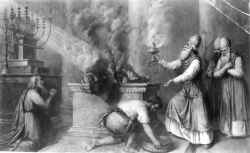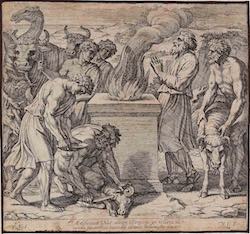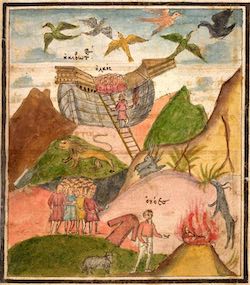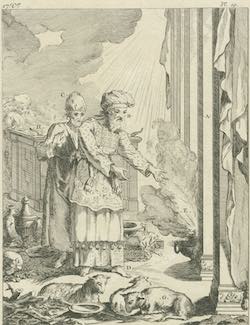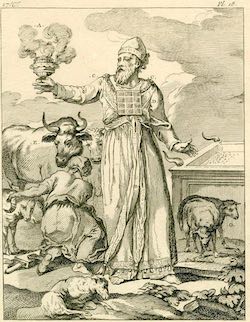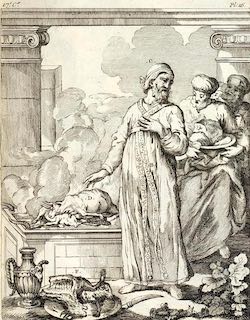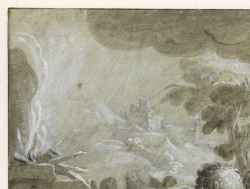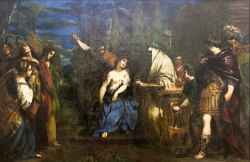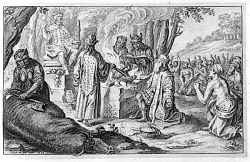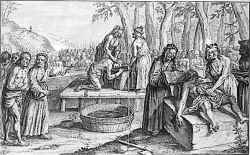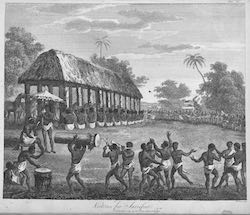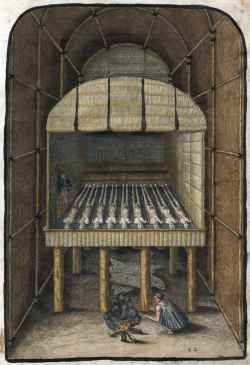Topic: 2. Sacrifice and religion: Comparisons, Antiquarians, Anthropology (16th-18th Century)
Religious sacrifices across various cultures and contexts sparked widespread interest in Early Modern Europe. As Christianity expanded into regions inhabited by "infidels" and "pagans", Europeans encountered a diverse array of sacrificial customs, ranging from the Sati rituals in India to the Aztec sacrifices in the Americas. This cross-cultural exposure captivated a wide audience, including theologians, philosophers, political thinkers, antiquarians, orientalists, missionaries, poets, artists, and even the general public. These encounters broadened the European understanding of sacrifice and led to a critical reassessment of classical and biblical sacrificial rites. This section includes:
- Sources: A selection of early modern printed materials, which include descriptions of the Americas, Asia, and Africa, alongside antiquarian and philological studies on religious sacrifice in classical antiquity and beyond. It also presents early modern works of ethnological observations and the first attempts to compare different sacrificial practices in various traditions and contexts, laying the groundwork for disciplines like the history of religions and anthropology.
- Iconographic Representations: A rich collection of images from the 16th to 18th centuries, illustrating a range of sacrificial rituals and practices as seen in different cultural and geographical contexts.
- Related Bibliography: An extensive bibliography spanning scholarly works from the 19th to 21st centuries, providing contemporary analyses and interpretations of these early studies and observations.
I diecimila martiri, San Maurizio e il massacrodella legione tebana (1528-1530)
from: Catalogo generale dei beni culturali
Galleria palatina, Firenze
Sacrifices among the Jagas (Sacrificio de Giaghi) (1665-1668)
from: Missione Evangelica al Regno del Congo [Araldi Ms, vol. C]
Gallerie Estensi, Biblioteca Estense Universitaria, Modena
Sacrifice of Noah (1649)
from: Gabinetto Disegni e Stampe, Fondo Nazionale; Pio; volume 8F.PIO
Istituto Centrale per la Grafica
Noah, his family and the animals leave the ark and offer sacrifice to God (1500)
from: Metrical Paraphrase of Genesis and Exodus [Ms Add. 40724, fol. 23]
British Library, London
A Jewish priest and high priest preparing to offer a sacrifice (1785)
from: Dandré-Bardon, Michel François, Costume des anciens peuples, a l'usage des artistes / par M. Dandré Bardon ; contenant les usages religieux, civils, domestiques & militaires des Grecs, des Romains, des Israélites & des Hébreux, des Egyptiens, des Perses, des Scythes, des Amazones, des Parthes, des Daces, des Sarmates & autres peuples tant orientaux qu'occidentaux, Paris, A. Jombert, 1784-1786, vol. 3
a Jewish priest and high priest preparing to offer a sacrifice (1785)
from: Dandré-Bardon, Michel François, Costume des anciens peuples, a l'usage des artistes / par M. Dandré Bardon ; contenant les usages religieux, civils, domestiques & militaires des Grecs, des Romains, des Israélites & des Hébreux, des Egyptiens, des Perses, des Scythes, des Amazones, des Parthes, des Daces, des Sarmates & autres peuples tant orientaux qu'occidentaux, Paris, A. Jombert, 1784-1786, vol. 3
The Sacrifice of Lystra (1529-1530)
Getty Museum, Los Angeles
Sacrificium sub Lege Naturae, Sacrificium sub Lege Moysis, Sacrificium sub Lege Evangelica (Three representations of sacrifices) (1588)
Royal Library of Belgium (S.IV 86279)
Suovetaurilia, the sacrifice of a pig (sus), a sheep (ovis) and a bull (taurus) (1585-1588)
Rotterdam, Museum Boijmans van Beuningen
The sacrifice of Polyxena (1625)
Roma, Musei Capitolini
Giovanni II Bentivoglio and His Family (1488)
Chiesa di San Giacomo Maggiore, Cappella Bentivolgio, Bologna
A king sacrifices an animal in front of the statue of Thor (1639)
RKD – Nederlands Instituut voor Kunstgeschiedenis
Priesteressen doen voorspellingen aan de hand van ingewanden van geofferde mensen (Priestesses make divinations using entrails of sacrificed people) (1639)
Det Kongelige Bibliotek, Copenhagen , inv./cat.nr Tu 121-3
Victims for Sacrifice (1793)
from: Dalzel, Archibad. The history of Dahomy, an inland Kingdom of Africa, London, T. Spilsbury and Son, 1793
Andromache Mourning Hector (1783)
Museée du Louvre, Paris
The tomb of the weroans – An Algonquian burial house showing bodies on a raised platform and a priest squatting by a fire beneath the platform. (1590)
from: Thomas Hariot, Wunderbarliche, doch warhafftige Erklärung, von der Gelegenheit vnd Sitten der Wilden in Virginia, Franckfort am Mayn, Wechel-De Bry, 1590, plate 22
Cain murdering Abel (1576)
Metropolitan Museum of Art, New York

